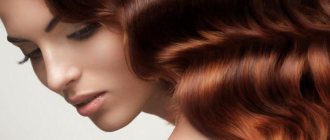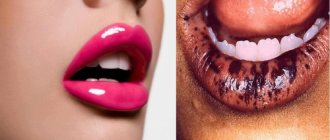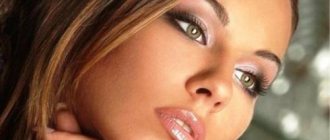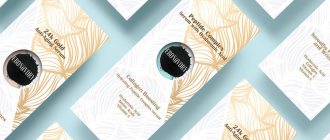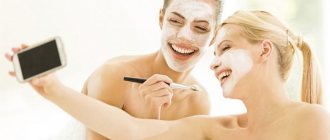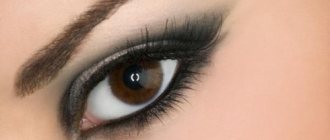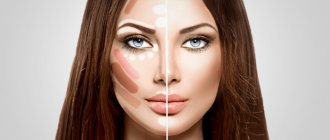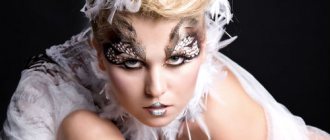Decorative cosmetics items
Cosmetics
(from ancient Greek κοσμητική - “the art of decorating, dressing up”, further from κοσμητικός, κοσμέω) - the doctrine of means and methods of improving a person’s appearance.
Cosmetics are also called products and methods for caring for the skin, hair and nails, as well as the oral cavity, used to improve a person’s appearance, as well as substances used to give freshness and beauty to the face and body[1]. Cosmetology
is a branch of medicine that develops means and measures to improve a person’s appearance (his facial and body skin) by masking or eliminating skin defects, using plastic surgery, etc.
Cosmetics are divided into two main groups: hygiene (soap, lotion) and decorative cosmetics (lipstick, mascara).
The word "cosmetics" was first used in 1867, during the International Exhibition in Paris, where the perfumery and soap industries exhibited their products separately from pharmaceuticals[2]. Soon the symbiosis of perfumery and soap making turned into a separate industry, which we now call the perfumery and cosmetics industry.
Each country has its own list of cosmetics, fixed by law. So, in some countries soap is not classified as cosmetics. The Food and Drug Administration defines cosmetics as essentially anything that can be “rubbed, poured, scattered or sprayed, injected, or otherwise applied to the human body... to cleanse, beautify, enhance attractiveness, or alter appearance.”
[3]. In Russia, the list of cosmetics includes essential oils, the main tools of aromatherapy.
The authoritative organization that classifies cosmetic products is CIDESCO - the international committee for cosmetology and aesthetics. It is this classification that is considered generally accepted and divides cosmetic products into a segment: the mass market
), the market for middle category goods (
middle market
), luxury, professional and cosmeceuticals[4].
In the modern world, there is a trend towards convergence between cosmetics and pharmaceuticals. A new type of cosmetics is emerging, which is a mixture of cosmetics and drugs. This direction is called " cosmeceuticals"
" However, many countries, and, in particular, the United States, consider this direction in the development of cosmetics to be dangerous to human health, and require that manufacturers clearly separate drugs and cosmetics.
Content
- 1 History of decorative cosmetics
- 2 Cosmetics in Russia
- 3 Basic cosmetic products and accessories
- 4 Cosmetics for facial skin care
- 5 Composition of cosmetics
- 6 International nomenclature of cosmetic ingredients
- 7 Safety requirements
- 8 Dangerous and useless ingredients in cosmetics 8.1 Endocrinological side effects
- 8.2 Dioxane (1,4-dioxane)
- 8.3 Nitrosamines
- 8.4 Coenzyme Q10 and vitamin C
- 9.1 Sensitive skin
History of decorative cosmetics[ | ]
See also: Cosmetics in Ancient Rome
Toulouse-Lautrec. Woman Having a Facial (1889)
In Ancient Egypt, eyeliner among the pharaohs had nothing to do with cosmetics, but was a necessary attribute of protection from evil spirits. By lining the eyes, the Egyptians drove away spirits, which they believed tended to penetrate the human soul through the eyes. The oil fragrant cones that the Egyptians wore on their heads also had nothing to do with cosmetics: living in a humid and hot climate, they protected themselves from the rays of the sun and insects in this way. The ancient Egyptians used aromatic oils and ointments to cleanse and soften their skin, protect it from sun and wind, and even mask body odors[5].
The inhabitants of Ancient Rome were well versed in the art of makeup. They extensively used kohl (charcoal) as eyelid dye, fucus (focus), mostly red in color, for cheeks and lips, wax as a hair remover, barley flour and oil for removing pimples, and pumice - for teeth whitening. They also dyed their hair black or blond depending on fashion trends.
Cosmetics in the modern sense, as a means of improving appearance, appeared about one and a half thousand years ago: the ancient Greeks revived the ancient Egyptian traditions of painting the face, but no longer as something vital, but solely for aesthetic purposes. By the 4th century. BC e. The Greeks removed their body hair, filled their eyebrows, applied white foundation to their faces, painted their lips, brushed their teeth, chewed gum and dyed their hair golden. When examining Minoan frescoes, vessels, and decorative items, one can understand that women of that era widely used cosmetics: using red paint for the lips, white for the face, black for the eyes. They also used special tweezers to pluck thick eyebrows[6]. Following them, other peoples began decorating the appearance. Now we call this process “make-up” or “applying decorative cosmetics”[7].
In Europe during the medieval period, it was fashionable to have pale faces. Rich people, who did not need to work outdoors and expose their faces to a tan, emphasized their well-being by having a pale complexion. Spanish prostitutes, on the contrary, painted their faces pink, thereby emphasizing their difference from the pale-faced women of high society. In the 13th century, royal women wore pink lipstick to demonstrate their affiliation with the highest authority.
During the Italian Renaissance, it was fashionable for women to paint their faces with lead white. Lead is harmful to human health, but unlike arsenic powder, it was not used as a poisonous substance. At that time, a powder called “Aqua Toffana”, named after its creator, Signora Toffana, was widely known in Italy. This powder was intended only for women from wealthy families. The container containing the powder contained an invitation to the client to visit Signora Toffana for instructions on how to use the powder. During the woman's visit, Signora Toffana explained to her that she should only powder her cheeks when her husband is nearby. As a result, with the assistance of Signora Toffana, six hundred husbands went to another world[8].
In Elizabethan England, cosmetics were considered unhealthy because it was believed that they did not allow moisture to evaporate naturally and interfere with the normal output of energy. During the French Restoration of the 18th century, red blush and lipstick symbolized passion, fury, and their owners were considered healthy, cheerful people. This was the case in France, but many people in other countries had a negative attitude towards excessive use of cosmetics. Opinions have often been expressed that French people wearing makeup are disgusting because they have something to hide.
In the 19th century, decorative cosmetics gradually began to enter everyday use; these were already products of natural tones, with the help of which faces were given a healthy ruddy color. But even then, excessive use of cosmetics was perceived negatively and was considered sinful.
The Victorian pale face remained in fashion until the 1920s, until the mass production and widespread trade of cosmetics began. In the 1960s, there was a turn in the decorative design of the face: instead of white lips and Egyptian eyes, fantastic images came into fashion, for example, a butterfly painted on the face. Such “decoration” was honored during country walks of high society. Until the late 1970s and early 1980s, looks with pronounced eyeliner in a variety of colors and shades remained in fashion.[9] but not only that.
Cosmetics in Russia[ | ]
Women of Ancient Rus' paid great attention to skin care and applying decorative cosmetics. The only difference from Western women was that they attached magical meaning to each color. Some colors were considered to attract love and good luck, while others, on the contrary, could bring misfortune.
Raspberry, cherry and beet juice were used as blush and lipstick. Eyes and eyebrows were lined with soot. The face was bleached with wheat flour. Onion peels were used to dye hair golden. To become blonde, they used a mixture of saffron and chamomile. Russian women took great care of their facial skin. They used milk, sour cream, honey, egg yolk, animal fat, as well as cucumbers, cabbage, carrots, and beets. Cucumber juice or parsley decoction was used to whiten and get rid of freckles. Cornflower infusion was used for oily, porous skin. Plantain, nettle, coltsfoot, burdock roots were used to treat dandruff and against hair loss.
Skin care recipes have been carefully described. Thus, in the 12th century, the granddaughter of Monomakh Zoe (Eupraxia) wrote the book “Ointments”; the Treatise of Eupraxia-Zoe is kept in the library of Lorenzo de’ Medici in Florence. The microfilm received in 1955 by Professor B. D. Petrov was translated and is located in the Russian State Library, where information was collected not only on the treatment of various diseases, but also tips on hair care, body care, remedies for bad breath and for brushing teeth. In the well-known at that time supplement to the magazine “Moskovskie Vedomosti” (published since 1756), “Economic Store”, published in Russia since 1780, various recommendations on appearance care and the use of herbal cosmetics were constantly published [10].
The industrial production of cosmetics in Russia began with the factory of Alphonse Ralet, founded in 1843 in Moscow. She produced powder, Tridas soap, lipstick and perfume. In 1846, Rala was allowed to print the Russian coat of arms on its products. The stores of his trading house were located in Moscow, St. Petersburg, Kharkov, and Odessa. After the Bolsheviks came to power, the Rale factory was renamed the Svoboda perfume and cosmetics factory.
In 1864, the soap laboratory of Heinrich Brocard was founded in Moscow. Things went well, and soon the factory began producing perfumes and lipsticks. Brocard was elevated to the rank of supplier to the Imperial Majesty's court. In 1878, Brocard was awarded a bronze medal at the World Exhibition in Paris, and later, in 1889, received the Grand Gold Medal. After the revolution, the factory was nationalized, and it continued to operate under the new name “New Dawn”.
In 1885, A. M. Ostroumov invented anti-dandruff soap, which immediately gained great popularity. The soap was followed by the Metamorphosis cream. After the revolution, the Ostroumov factory was merged with the Bodlot factory and received the name “Rassvet”.
Basic cosmetic products and accessories[ | ]
For the face
For the face, foundation, BB/CC cream, and powder are used; they even out the tone of the face and partially hide any imperfections. Before applying foundation, use a makeup base if necessary. It is needed to even out the relief, increase the durability of makeup, and correct color imperfections of the skin. Concealer and correctors are used to precisely hide imperfections. For visual modeling of facial sculpture, there is a sculptor, bronzer, and highlighter. Using them, for example, you can make your cheekbones more visible or visually change the shape or size of your nose.
For eyes
For eye makeup, there are shadows, cream shadows, tints; they allow you to visually correct the shape of the eye, hide drooping eyelids, and are also simply used to brighten the image as a whole. Pencil and eyeliner are needed mainly for drawing arrows; they are also used to visually emphasize the eyelash line and shade the color of the iris. Mascara makes eyelashes longer, more voluminous, more expressive, and you can also use false eyelashes for all this.
For lips
There are lipsticks and glosses for lips. Special lip pencils are also used to adjust the shape of the lips and thicken the color and add durability to the product applied on top.
For eyebrows
For eyebrows, special pencils, lipsticks, and gels are used.
Brushes
Most often, cosmetic products are applied with brushes. There are many types of brushes depending on what products they are intended for. In addition to using brushes, you can also apply products with sponges, beauty blenders, and directly with your hands or fingers.
Cosmetics for facial skin care[ | ]
Such cosmetics are divided into types, in accordance with the stage of skin care for which they are intended. The following types of care cosmetics are distinguished: cleansing, toning, moisturizing, nourishing and protecting the skin. Cosmetic products can also be divided depending on the skin type for which they are suitable: normal, dry, combination, oily, problematic.
How to choose the right decorative cosmetics
Very often, by making mistakes in choosing decorative cosmetics, women not only throw money away, but also harm the health of their skin and appearance. Therefore, it is important to know the basic rules for choosing cosmetics.
For example, when choosing a foundation, you should take into account not only the coverage density and ease of application, but also your skin type. For dry or normal skin, it is recommended to choose a satin radiant coating with a cream texture that will moisturize the skin and give a healthy tone. For oily skin, a matte finish with a cream-powder texture is ideal, which will prevent the appearance of oily shine. For sensitive and problem skin, it is best to choose foundations that do not contain oils or fragrances.
In addition to the texture of the foundation, it is necessary to take into account its tone. You need to test your foundation on your chin or cheekbones. So, for tanned skin, sandy shades or ivory are perfect, and for pinkish or pale skin - light cream and beige shades.
When choosing blush, it is worth remembering that cream blush visually looks more natural, unlike powder blush. Blush in lilac and coral shades is ideal for dark skin, while peach and soft pink are ideal for light skin.
Eye shadow is tested on the inside of the wrist using a cotton pad. Shades of shadows are selected depending on the color of the eyes, hair and skin tone. It is best to opt for loose eyeshadows, since liquid ones tend to roll off and smear.
Eyeliner pencils are tested on the back of the hand, and then run over it with a finger; if the eyeliner is completely smeared, then you should not purchase it.
Currently, there is a large selection of mascara that has certain properties; the best mascara has a thin and long brush. When choosing the shade of this cosmetic product, it is necessary to base it on the color of the eyes, so black mascara will suit everyone, green, blue and burgundy for brown-eyed ladies, and purple will emphasize gray-blue and green eyes.
Testing of lipstick and lip gloss is carried out on the fingertips; after application, it is worth checking the product for stickiness. Also, each lipstick has a special mark, for example, “gloss” means that the lipstick will add shine, and “lacquer” means maximum color.
In addition to determining the texture and tone, you must carefully read the composition of each product; high-quality cosmetics should always contain vitamins (usually A, E and C), hyaluronic acid and plant extracts (jojoba or avocado oil; rosemary, calendula or chamomile extract; aloe vera juice ). It is also worth paying attention to the expiration date. Recently, manufacturers of decorative cosmetics do not indicate the production date on the tube; instead, they apply a code that does not give any information to the person. According to European standards, decorative cosmetics in packaging can be stored for 36 months.
Composition of cosmetics[ | ]
| This section is missing references to information sources. Information must be verifiable, otherwise it may be questioned and deleted. You may edit this article to include links to authoritative sources. This mark was set on February 5, 2014 . |
Cosmetics consist of various ingredients that perform specific functions. The same ingredient can have several properties. All ingredients are divided into groups:
- Abrasive substances are materials of increased hardness, used in a massive or crushed state for mechanical processing of other materials. Natural abrasive substances - flint, emery, pumice, corundum, granite, diamond, etc.
- Absorbers (absorbents)
- Anti-dandruff substances
- Antimicrobial agents
- Antioxidants are natural or synthetic substances that slow down or prevent the oxidation of organic compounds. They are used both to protect the cosmetic product itself from oxidation and to protect the skin from free radicals, which are one of the causes of skin aging.
- Antistatic agents are substances that reduce static electricity and are used in shampoos and hair conditioners.
- Binders are substances intended for gluing grains of quartz sand and other fillers of the core mixture or molding sand.
- Biological additives are compositions of biologically active substances.
- Whitening agents - help fight skin pigmentation.
- Herbal ingredients - this includes plant extracts, oils and other ingredients that benefit the skin.
- Buffer substance
- Chelating agents are substances due to which additional non-covalent bonds arise in those structures in which a hydrogen (or metal) atom connected by a covalent bond is oriented between two electron-donating fragments of the same molecule, providing this hydrogen (or metal) atom with additional electronic cloud.
- Dyes
- Denaturants are mixtures of ethyl alcohol (base) with a small amount of methanol and kerosene or other denatured alcohols, depending on the legislation of the country. Denatured alcohol or denatured alcohol is intended for various technical and medical purposes, but not for the production of any alcoholic beverages. Denaturants can also be called industrial alcohols, since these alcohols are used EXCLUSIVELY for technical or industrial purposes.
- Hair removal agents
- Emollients are substances that soften skin and hair.
- Emulsifiers are emulsion stabilizers that help create a uniform consistency of creams.
- Film-forming
- Foaming
- Flavorings (fragrances) - may cause allergies.
- Moisture-retaining substances help moisturize the skin.
- Contrasts
- Oxidizing agents
- Pigments
- Preservatives
- Various gases
- Skin regenerating ingredients contribute to its restoration.
- Solvents
- Surfactants or surfactants are used in cleansers and shampoos.
- UV filters - protect the skin and product from solar radiation.
- Viscosity regulators - makes the product thicker or, conversely, liquid with a fluid texture.
When formulating a cosmetic, many aspects are taken into account: it must attract customers with its aroma and consistency, be convenient and easy to use, and most importantly, fulfill its main purpose - improve appearance, give freshness and beauty to the face, body, hair, nails, etc. In order to comply with all the requirements, many substances are added to the formulation that are not related to its main purpose - caring for appearance. The inclusion of additional substances in cosmetics is due solely to marketing considerations [ source not specified 3380 days
]. These include anti-corrosion substances, antistatic agents, binders, contrasters, and viscosity-regulating substances. The addition of emulsifiers, for example, is due to the need to mix substances that do not mix in nature - fats, oils and water, otherwise the cosmetics will not have a marketable appearance, will spread and separate.
The main purpose of preservatives in cosmetics is to prevent the growth of harmful microorganisms that can lead to various diseases, and also to ensure that cosmetics retain their presentation for as long as possible: they do not separate, do not lose consistency, and do not change color or smell. If a cosmetic contains water and fat, two preservatives are usually added to such cosmetics - to protect the water part and to protect the fatty part of the cosmetic.[8] Mainly used as preservatives [ source not specified 3380 days
] so-called "parabens".
Research on the safety of cosmetic ingredients can be found in the CIR[11] and the Environmental Working Group, where links to ingredient studies are provided.
How they washed
Then we washed ourselves, sweating in the bathhouse and spreading olive oil on ourselves, which was then removed with a special tool similar to a curved, blunt knife or scraper - a strigil. Soap was known, but it was too harsh for the body - they only used it for washing.
In Ancient Rome, such “scrapings” of gladiators were highly valued and sold very expensively - they were considered universal aphrodisiacs and were used as cosmetics on their own or as part of preparations to attract the opposite sex.
In the Middle Ages, modern medicine, which stubbornly preferred the theory of miasma, introduced corrections into the matter of cosmetics. The essence of the idea is simple: all diseases are caused by bad odors. If you want to improve the environment and health, improve and ennoble the smells. This point of view existed almost until the middle of the twentieth century. This did not help medicine as such, but this misconception gave chemistry and perfumery a significant boost.
Often perfumers were also pharmacists. And vice versa. There was no special control over the process, and therefore each author was as clever as he wanted. And not always useful. It happened that the clientele died. However, this was not associated with perfumes and medicines. This is the will of the Almighty.
Perfumes, sachets, lipsticks, powders were invented and used in unimaginable quantities at that time. Stunned by such demand, alchemists and perfumers came up with a lot of new methods and technologies.
They washed themselves with perfume, washed their hands, dried themselves. They even drank them. Napoleon Bonaparte, by the way, consumed up to three bottles of cologne per day.
But they rarely applied anything to the skin. More often, handkerchiefs, collars, hats, and wigs were anointed with perfume. It was simply believed that this would clog the pores, and therefore disrupt normal air exchange and the normal functioning of the skin. It’s curious, but it was for this reason that they tried to take baths less often - the bath opens the skin and reduces the body’s defenses.
International Nomenclature of Cosmetic Ingredients[ | ]
The rapid development of the cosmetics industry required streamlining the work with the ingredients that make up cosmetics. This was undertaken by an organization founded in 1894 - The Cosmetic, Toiletry, and Fragrance Association (now The Personal Care Products Council). CTFA is the author of the International Nomenclature of Cosmetic Ingredients. The first CTFA dictionary of ingredients was released in 1973. It included only 5 thousand ingredients. Each was assigned a number according to the Chemical Abstract Service Registry (CAS). In 1994, the fifth edition of the dictionary was released, which was called the International Cosmetic Ingredient Dictionary and contained 6,000 ingredients. In 2006, the 11th edition was released, but already under the name of the International Nomenclature of Cosmetic Ingredient (INCI), which contained more than 13 thousand ingredients (in 12 years the number of ingredients has more than doubled).
In 2010, the 13th edition of the International Cosmetic Ingredient Dictionary & Handbook was released, which already includes 17.5 thousand ingredients.
In Russia there is no single dictionary of cosmetic ingredients. However, the legislation mentions INCI and gives the following recommendations: “At the discretion of the manufacturer, it is permissible to indicate the list of ingredients in accordance with the International Nomenclature of Cosmetic Ingredients (INCI) using a Latin graphic basis.”[12]
Russian cosmetics
In Russia, industrially produced cosmetics were poorly introduced. Perfumer Brocard complained about this from 1904 to 1913. Most people washed themselves with vinegar or lye, and for scents they preferred sweet clover in the linen closet.
Vinegar could also be used for blush - the acid irritated the skin, causing it to turn red.
The beauties of the Russian Empire used a mixture of soot and sound soap as mascara. The thing turned out to be expressive, but crying and getting caught in the rain was not good with such eyes - it cut mercilessly.
Brasmatics and brushes were not allowed. Mascara was applied with fingers. Sometimes artistic brushes from kolonka were used.
Acne was fought with boric alcohol, which we diluted ourselves. Sometimes (much later) plivasept was added. Now they claim that this is not very useful. But then the remedy was in use.
A mixture of soap and hydrogen peroxide was used to remove unwanted body hair. For those who want to try, I inform you that such a hellish mixture ate not only the hair follicles, but also the pigmentation of the skin. But this side effect was considered minor.
These funds survived well into Soviet times. The combination of such beauties with carrot lipstick could be found even during the time of Brezhnev. And immediately after the war, everything was used - from grated brick to burnt linden splinters for blackness and outline. So beets and hydrogen peroxide were still a luxury.
Even I encountered something similar (albeit rarely) in the 1970s. True in the village. And among very ancient grannies.
Dangerous and useless ingredients in cosmetics[ | ]
Harmful ingredients and impurities in cosmetics are much more common than we would like, and some of them pose a real threat to health. Notorious ones include: 1,4-dioxane, nitrosamines, and chemicals that affect the endocrine and hormonal systems.
Endocrinological side effects[ | ]
In modern industrial society, a large number of chemical compounds are released into the environment, which have a negative impact on human health, and, in particular, on the endocrine system and the hormonal background of the body as a whole. These substances are called xenoestrogens[en]. They get into cosmetics and food products from plastic packaging. Xenoestrogens are also present in detergents as surfactants and antioxidants and are used in cleansers, cosmetics, toiletries and foods. For example, BHA (Butylated hydroxytoluene) is used as an antioxidant. Substances belonging to the phthalates group: dibutyl phthalate, di-2-ethylhexyl phthalate, di-isopropyl phthalate and benzyl butyl phthalate. Their danger lies in the fact that they tend to accumulate in the tissues of the human body, and over time the level of their content becomes higher and higher, which can affect the functioning of the endocrine system[16].
Dioxane (1,4-dioxane)[ | ]
This substance is a well-known carcinogen (a substance that causes cancer). 1,4-dioxane was created accidentally as an unwanted byproduct in the production of certain cosmetic ingredients - when two molecules of ethylene oxide combine during a chemical reaction. Before using the ingredient in cosmetics, this chemical compound must be carefully removed by vacuum evaporation. Ethylene oxide is also used in cosmetics as a surfactant, emulsifier and film former. In cosmetics, it can be identified by name: PEG, polyethylene glycol, polyoxyethylene, as well as chemicals ending in “-eth” (for example, the laureth family) or “-oxynol.”[8].
Nitrosamines[ | ]
Nitrosamines, otherwise called N-nitroso compounds, are aggressive carcinogens that can enter the human body through the skin. They are not used as ingredients in cosmetics, like dioxane. They can form accidentally during the preparation of individual ingredients, or through the interaction of two completely safe ingredients in the final product. Even chemicals released from human skin can react with ingredients to form nitrosamines. Some ingredients are known to be nitrosating agents, for example: sodium nitrite, used as a corrosion inhibitor, some hair dyes, preservatives such as 2-bromo-2-nitropropane-1,3-diol (BNPD; bronopol) and 5 -bromo-5-nitro-1,3-dioxane (bronidox; C Bronidox)[17]. Therefore, well-known cosmetics manufacturers do not use these ingredients in cosmetics. [ source not specified 3291 days
] However, these substances can be found in cosmetics produced in the post-Soviet space.
Coenzyme Q10 and vitamin C[ | ]
They are actively used in anti-aging cosmetics and are also actively advertised by their manufacturers as effective ingredients in the fight against wrinkles. However, these substances are destroyed quite quickly under the influence of the environment, so very little of them penetrate into the deep layers of the skin.
Cosmetics in Ancient Greece
Ancient Greece also loved cosmetics. You can read about cosmetics in Homer’s Odyssey and in the works of the famous ancient Greek physician Hippocrates, who described a number of means that allow women to become even more beautiful.
Greek women painted their lips, blushed their cheeks, and lightened their hair. Greek girls made mascara from soot, lipstick from cochineal (aphids) or with the addition of red lead and cinnabar pigments, which, by the way, are poisonous.
The physician Claudius Galen will write about the toxicity of some cosmetics, and therefore their harm, later, in the times of Ancient Rome. After all, cinnabar is a mercury mineral, and minium is a mineral containing lead, which is no less harmful to health. However, Roman women will still use their lipsticks.
Diseases caused by cosmetics[ | ]
Sensitive skin[ | ]
Many women who think they are allergic to cosmetics are actually suffering from irritation caused by one or a group of chemicals in cosmetics. Research conducted in the EU[18] showed that 42% of women believe that they have sensitive skin. If the skin reacts quickly to the use of cosmetics containing irritating components, then we can say with confidence that it is sensitive skin. Often, symptoms such as itching, red spots, and sometimes a rash (urticaria) quickly disappear if the affected area is washed with water or a soothing lotion. As a rule, skin sensitivity is provoked by fragrances and coloring chemicals, as well as preservatives, sunscreens and many others, both natural and synthetic. Skin sensitivity can also be congenital. Such skin is characterized by a light tone and thin epithelium; a visible and tangible reaction by the body to changes in environmental temperature (redness, tingling), as well as ultraviolet radiation (as a rule, such skin produces a relatively small amount of melanin, as a result of which it quickly turns red in direct sunlight).
Allergy[ | ]
An allergic reaction occurs when the body's immune system reacts with a substance that does not normally cause such reactions in other people. Symptoms of allergies are: itching, formation of tumors on the skin, rash. The occurrence of simple allergic reactions can be avoided if you stop using cosmetics that cause a negative effect. Such drugs can only be identified by consulting a doctor or by performing an allergy skin test[19].
Acne and blackheads (comedones)[ | ]
Blackheads occur when the skin's hair follicles, or oil glands, become blocked by an oily mixture of sebum (the skin's natural oil) and keratin (the rough, fibrous protein that coats the skin, hair, and nails). This mixture hardens and turns into a cork, which turns black when in contact with air. If bacteria get into such plugs and gain the ability to multiply, then blackheads with black heads become infected and red pimples - acne - form. One of the causes of acne is oily or greasy substances that penetrate into the pores of the skin along with cosmetics and clog them.[8]
Fashion for cosmetics
At the same time, the fashion appeared to paint nails with henna - it was a sign of noble blood. By the way, a little later, in the East, men tinted their beards with henna - this was an indicator of high status. Not everyone had the right to do this. As later in Rome, not everyone had the right to purple - that was the emperor’s palette.
The Greeks adopted the fashion for cosmetics from the Egyptians. Honey and olive oil, spices and wax were used. The last thing, by the way, was epilation - the Greeks had a habit of getting rid of body hair completely, regardless of gender.
It’s curious, but this habit of caring for oneself made it possible to ignore the parasites. The understanding that it is possible to do without helminths and skin parasites came to humanity only at the end of the 19th century.
Before that, lice and worms were perceived as obligatory companions. Archaeologists from Pompeii, Stabia and Herculaneum claim that the infection of ancient people with such rubbish was widespread.
Noble ladies painted their lips red - red has always been considered the destiny of aristocrats. The lipstick, by the way, contained dog fat.
Standards for natural cosmetics[ | ]
| This section is missing references to information sources. Information must be verifiable, otherwise it may be questioned and deleted. You may edit this article to include links to authoritative sources. This mark was set on February 5, 2014 . |
On September 1, 2009, the European Communities, with the participation of BDIH (Germany), Bioforum (Belgium), Cosmebio & Ecocert (France), ICEA (Italy) and Soil Association (UK), adopted the Cosmos-standard for natural and organic cosmetics.
Natural and organic cosmetics must contain five types of ingredients: water, natural minerals, plant ingredients obtained by physical and chemical methods, as well as other groups of ingredients.
Manufacturers of cosmetics who declare their products as natural are required to provide the following information: the origin and method of obtaining ingredients, the full composition of cosmetics, storage conditions, production and type and quality of packaging, environmental conditions, various certificates of conformity.
It is prohibited to include nanomaterials in natural and “organic” cosmetics, to use raw materials from genetically modified products, or radioactive substances. It is also prohibited to test cosmetics on animals. However, such testing of ingredients is permitted based on the laws of the country of origin.
To classify an ingredient as “natural” or “organic”, special formulas are used that take into account the following ratios: quality of raw materials, method of obtaining the ingredient and other indicators. As a result, each ingredient is assigned a certain numerical value - points.
In order for a brand's products to be certified as "organic" or "natural", 95% of all natural ingredients used in the composition must be produced using physical methods and no less than 20% of cosmetics from one brand must be certified "organic". The exception is rinse-off cosmetics (for example, cleansers), lotions and powder. At least 10% of this type of cosmetics can be certified as “organic”.
Cosmos-standard also describes in detail the containers in which organic cosmetics can be stored. In particular, it is prohibited to store such cosmetics in plastic containers[20].
A distinctive sign for natural cosmetics and “organic” cosmetics is the labeling of cosmetics with the following designations: “Cosmos-Organic” or “Cosmos-Natural”. In the name of cosmetics, designations such as “organic shampoo”, etc. are not allowed. The correct spelling is: “Shampoo with organic jojoba oil”[21].
The Ecocert standard (France) guarantees that:
- In the production of products, environmentally friendly raw materials are used (obtained without the use of pesticides, chemical fertilizers, growth regulators).
- The production process does not harm the environment.
- The products consist of 95% natural ingredients and do not contain parabens, phenoxyethanol, GMOs (genetically modified organisms), mineral oils, paraffin, petroleum jelly, synthetic fragrances and dyes and other harmful substances.
In Russia there is no clear definition of what constitutes “natural” or “organic” cosmetics. At the moment, there is only one Russian standard for natural cosmetics - Bio.Rus, its rules are less stringent than those of the main international standards[22].
Mineral cosmetics: when did the boom happen?
About 35-40 years ago there was a boom in mineral cosmetics. This phenomenon was facilitated by two interesting historical facts that took place just a couple of decades ago.
- The US government has obliged cosmetics manufacturers to indicate the composition of their products on the packaging. Cosmetologists, doctors and chemists were shocked! It turned out that world-famous brands add a huge amount of “chemicals” to lipsticks, powders, eye shadows, and mascara, not sparing beauties who want to transform themselves and, as a result, buy such products in huge quantities.
- Hollywood stars needed to constantly wear makeup. If they had used cosmetics of those times in everyday life, which were not only harmless, but also unsafe, this would have led to disastrous consequences. Therefore, for makeup between filming, world stars began to use mineral cosmetic products. As a result, plastic surgeons, cosmetologists and even doctors noticed that such products not only hide marks from operations (scars and scars), squeezing out pimples, but also prevent further irritation of the skin.
Notes[ | ]
- Ozhegov S. I.
Explanatory dictionary of the Russian language / Shvedova N. Yu. - M.: A TEMP, 2008. - 944 p. — ISBN 978-5-990-03586-7. - World Exhibition. Paris. 1867. Illustrated description of the World Industrial Exhibition in Paris in 1867 (Russian). www.minfin.ru
(12/10/2018). — section Documents, Illustrated description, chronicle of the exhibition.. - Cosmetics Labeling Guide (English). https://www.fda.gov
(11 May 2017). - History (Russian). www.cidesco.ru
(2018). - History of cosmetics (English). https://cosmeticseurope.eu
. Cosmetics Europe (2020). - Anna Kofu.
Crete / Christiana G. Christopolou. - Athens, Greece: Ekdotike Athenon SA, 2006. - P. 54. - 296 p. — ISBN 960-213-432-1. - N. Vinogradova, L. Golan.
Formula of perfection (Paperback) (Russian). - USA: AND Group, 2006. - ISBN 978-1-4303-0772-3. - ↑ 1 2 3 4 Gina Antczak, Stephen Antczak.
Cosmetics Unmasked: Your Family Guide to Safe Cosmetics and Allergy-Free Toiletries (Paperback) (English). - USA: Thorsons, 2001. - ISBN 978-0-00-710568-7. - N. Vinogradova, L. Golan.
Fundamentals of Phytocosmetology (Russian). - USA: AND Group, 2009. - ISBN 978-1-4116-8065-4. - Great Soviet Encyclopedia
- Cosmetic Ingredient Review (English). www.cir-safety.org. Retrieved December 11, 2020.
- Rules for certification of perfume and cosmetic products. (as amended by Amendment No. 1, approved by Resolution of the State Standard of the Russian Federation dated June 18, 2002 No. 40)
- Technical Regulations of the Customs Union 009/2011 “On the safety of perfumery and cosmetic products” (Russian). Archived from the original on December 5, 2012.
- FDA Authority Over Cosmetics.
- Cosmetics section on the FDA website (English).
- David Steinman, Samuel S. Epstein.
The Safe Shopper's Bible: A Consumer's Guide to Nontoxic Household Products, Cosmetics, and Food (Paperback). - USA: Wiley, 1995. - ISBN 978-0-02-082085-7. - Aubrey Hampton.
What's in Your Cosmetics?: A Complete Consumer's Guide to Natural and Synthetic Ingredients (Paperback) (English). - Odonian Prlocation=USA, 1995. - ISBN 978-1-878825-45-2. - In November 2006, the EU adopted a resolution on the creation of a special “Cosmetovigilance” system. It was proposed to create an independent database on the negative impact of cosmetic products on human health.
- Pamela Hill.
Milady's Aesthetician Series: Common Skin Diseases: A Handbook for the Aesthetician (Paperback) (English). - USA: Milady, 2007. - ISBN 978-1-4018-8170-2. - Myths and reality of natural cosmetics (Russian) // Raw materials and packaging for perfumery, cosmetics and household chemicals: magazine. — 2014. — July–August (No. 06 (156)).
- COSMOS-standard (English). Archived from the original on December 5, 2012.
- Puchkova Tatyana.
Bio.Rus.
Our Certification System (Russian). www.1nep.ru
(09.11.2012).
